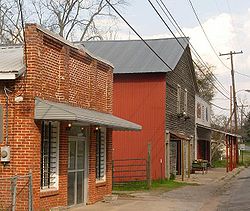Loachapoka, Alabama
| Loachapoka, Alabama | |
|---|---|
| Town | |

Loachapoka Town Hall (left) and Fred's Feed & Seed and Pickin’ Parlor (right)
|
|
 Location in Lee County, Alabama |
|
| Coordinates: 32°36′17″N 85°35′49″W / 32.60472°N 85.59694°W | |
| Country | United States |
| State | Alabama |
| County | Lee |
| Area | |
| • Total | 1.2 sq mi (3 km2) |
| • Land | 1.2 sq mi (3 km2) |
| • Water | 0 sq mi (0 km2) |
| Elevation | 679 ft (207 m) |
| Population | |
| • Total | 180 |
| Time zone | CST (UTC-6) |
| • Summer (DST) | CDT (UTC-5) |
| ZIP code | 36865 |
| Area code(s) | 334 |
| FIPS code | 01-43744 |
| GNIS feature ID | 0121934 |
| Website | http://www.soppin.org |
Loachapoka is a town in Lee County, Alabama, United States. It is located less than 1/2 mile west of the City of Auburn and approximately 5 miles West of Auburn University main campus, in west-central Lee County. The population was 180 as of the 2010 census, up from 165 in 2000. It is part of the Auburn-Opelika, Alabama Metropolitan Statistical Area.
The name "Loachapoka" means "turtle killing place" in Muskogee, with locha meaning "turtle" and poga meaning "killing place." In literature, Lochapoka was the destination of the colonists in James H. Street's 1940 novel Oh, Promised Land.
Loachapoka is the location of the first Rosenwald School.
Loachapoka is governed by a mayor and 5 town council members. However, in the most recent municipal election (2016), no incumbents submitted qualifying paperwork to run for re-election. Therefore, the only citizen that did qualify for the ballot became mayor-elect, as per state law, and this was confirmed by the AL Director of Elections. When the mayor-elect brought the issue to light, several town, county and state officials worked together in a poorly hatched plan to improperly disqualify the only candidate to follow the law for qualification, as referenced in several newspaper articles and audio recordings of town hall meetings.The corruption portrayed in this series of events reflect a pattern of politics in Alabama that has been commonplace for many years, as reported in the Harvard Political Review.
Loachapoka was a Creek Indian town for some decades prior to white settlement. In the last census prior to the Native removal to Oklahoma, Loachapoka was found to have a population of 564. Upon settlement by Euro-Americans, Loachapoka—temporarily renamed Ball's Fork—became the regional trade center, a position that was reinforced in 1845 when it became the easternmost point on the railroad to Montgomery. Loachapoka's influence peaked in the early 1870s, when her population reached nearly 1,300. Within a few years, a collapse of trade due to the Panic of 1873 and additional rail lines in the area sent Loachapoka into economic decline. Loachapoka roughly stabilized as a small farming community by the mid-20th century, and by the early 2000s (decade) had become a small-town suburb of Auburn.
...
Wikipedia
